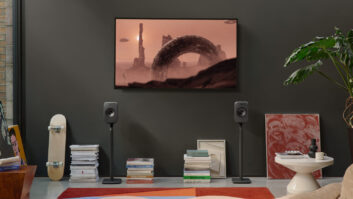PCS ’99 should find itself at home in New Orleans this week with a display of devices and services that make getting in touch and staying informed easier than ever.
New multipurpose mobile phones with sleek designs will be there, along with the latest developments in CDMA and TDMA; PDAs with wireless functions; and add-ons making their debuts.
Mobile phone manufacturers are gearing up for PCS ’99, where they’ll have the opportunity to show off some of their latest design and technological innovations.
NEC America’s Wireless Marketing Division will present its new DigitalTalk NEX series of cellular phones at the show. These phones add a new look to NEC’s product line. They’re somewhat sleeker and more stylish than what people are used to seeing from NEC.
The two models, the 2600 and the 2200, are about half the size of NEC’s current product line and, according to the company, will be among the lightest phones on the market, weighing in at 4.6 ounces with the lithium-ion battery. The 2600 will be available later this fall, and the 2200 should be at retail by spring 2000.
Also, the DigitalTalk NEX 2600 will be NEC’s first trimode, dual-band (800 MHz/1.9 GHz) phone. As for battery duration, digital with an NiMH battery will give a user up to 140 minutes of talktime. Digital with a lithium-ion battery will allow up to 230 minutes of talktime. On standby the phones get 100 hours on the NiMH battery and 150 hours on the lithium ion.
Ericsson will be showing off its T18d mobile phone. The unit offers the latest trimode technology for TDMA systems, which allows for enhanced coast-to-coast coverage and better access in densely populated urban areas. It operates in digital mode in the 800-1,900MHz frequency bands and in analog mode in the 800 MHz range.
The T18d has a built-in PCMCIA card and is one of the first TDMA phones to support Digital Data/Fax. This new technology means a user can fax in digital mode with cleaner and more secure transmissions. The integrated modem supports data, fax and Internet calls.
The T18d weighs in at 5.4 ounces and features a 750-mAh NiMH battery that can last up to four hours in talk mode and 80 hours in standby. A high-capacity phone book allows users to store up to 250 names. Suggested retail price is $199, and the phone should be at retail by the end of next month.
Ericsson’s R250d PRO, called “The Rock,” is a departure for the company’s traditional design approach. This phone is made to withstand harsh environments and overall rough treatment. But it also has advanced trimode technology, push-to-talk radio-type features and PRO-Group calling. All this is encased in a rugged rubber “over-mold.”
The Rock’s Xtreme-Seal design meets U.S. military requirements for ruggedness, the company said. It is constructed of magnesium reinforced with a high-impact Ballistech rubber, weighs 9.5 ounces, and features a keypad with large rubber buttons permanently mounted in the front casing to keep out dust particles and water. It offers up to four hours of talktime and 80 hours of standby.
The suggested retail price is $299, and it should be at retail by the end of this year.
Qualcomm’s focus will be on Code Division Wireless Access (CDMA) digital data and the products that support data functions, such as its Thin Phone series.
Also, keep your ears open for the latest talk on content delivery. NeoPoint has caused a stir with its model 1000 smartphone, which it is now shipping to Sprint with the moniker Sprint PCS Phone NP1000. Along with voice capabilities the phone can handle sending and receiving e-mail, Internet access, and personal scheduling.
“NeoPoint is continually striving to provide simple, easy-to-use CDMA wireless handsets [that] meet the ever-changing needs of the mass market,” said CEO/president William Son.
The Wireless Application Protocol (WAP) Forum will also be making its presence known at PCS ’99, as a host of companies — including Lucent, Nokia, Motorola, Ericsson, RTS Wireless, Phone.com, Unisys and Spyglass — will be giving WAP demonstrations and announcing WAP product rollout plans. These companies and others will be pushing for WAP to be the worldwide standard for providing Internet communications and advanced telephony services on digital mobile phones, pagers, PDAs and other wireless devices.
As this technology comes into place, content providers are showing they are eager to offer their services. CNN Interactive announced it is joining with Sprint to offer CNN Mobile, a 24-hour news and information service, through what will be part of Sprint PCS Wireless Web service. This will be available to nearly 4 million customers across the country. CNN Mobile is the first value-added service to be built on the WAP.
In the latest PDAs, the people who developed the first PalmPilots and the Palm OS have taken their experience and success to their own company, HandSpring, and come up with a more “consumer-friendly” PDA: the Visor. This new line of PDAs also runs the Palm OS but checks in at a lower price point. The introductory Visor Solo has a $149 suggested price. 3Com’s lowest-price Palm IIIe is listed at $199. But the Visor isn’t just a knock-off. It has slots, or what HandSpring calls Springboard modules, and third-party developers are already gearing up for peripheral and accessory sales.
Innogear, a San Jose, Calif., company (formerly known as Parallel Design), has just announced two new products for the Visor: the MiniJam Digital Audio Player (MP3) and Voice Recorder and the InfoMitt pager.
“Innogear’s MP3 player and pager modules are great examples of the types of consumer-focused handheld solutions that are possible with the Springboard expansion platform,” said Bob Fullerton, founder and president of Innogear. His company has been making the GoType! Keyboard for 3Com’s Palm devices.
Minijam lets users play back MP3 files as well as record voice messages. Files are stored on an internal 64MB or external memory card.
The Minijam receives its power from the Visor. A power-management system will help keep the batteries from running down within a few minutes, but for extended play an auxiliary DC-in jack can be used. The product is expected to ship early next year, although a price has not yet been set.
InfoMitt can receive alphanumeric pages but can also receive e-mail and content in the form of “electronic magazines.” Users can sign up for service with Global Access, an Escondido, Calif., company that supplies pagers and paging services. The standard electronic magazines will have general news, weather, sports and content provided from other companies The InfoMitt will be shipping by the end of this year and will carry a $49.95 suggested retail price.
Other companies creating or providing content for Springboard modules and accessories include Concept Kitchen, DataStick, EA Sports, Franklin Covey, Glenayre’s Wireless Access Group, Imagiworks, Innogear, JP Systems, Karrier Communications, Landware, MarcoSoft, Navicom, Pacific Neo-Tek, Peanut Press, the RioPort subsidiary of Diamond Multimedia, Revolv Design, Shinei, Sycom, Think Outside and Widcomm.









